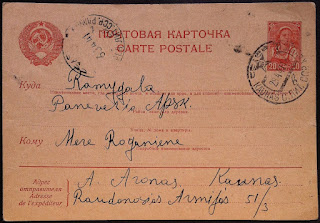 |
| Seinai (now Sejny, Poland) 16 May 1919 |
While collecting stamps for years, I'm pretty sure you have experienced a "what I thought it is, actually, wasn't" phenomena at least once. Well, it just happened to me so I thought I would post about it. This is a Lithuania classic stamp, to be precise, a Michel 14. I thought the postmark on it was an early example of Raseiniai postmark, for some reason labeling it so without much thinking. Recently, I was just going through my collection and one particular Raseiniai cancel on an air post stamp caught my eye. Why? well, I thought the size of the letter on the postmark is slightly smaller than the one on my Michel 14. So I took them our and compared, and wow wow wow! it wasn't "slightly" but pretty obvious!

Isn't it possible that 1919 Raseiniai cancel is bigger than the 1924's one? Maybe everybody knows it because it is mentioned in LPS journal and I'm the only one in the world not knowing about it... Or maybe some kind of previously not known Raseiniai cancel? I thought it would be wise to check on Lithuanian Philately.com before arming my fantasies with Icarus's wings.
 |
| 1919 Raseiniai and Seinai cancels taken from Lithuanian Philately.com. |
Looking further at my Michel 14 I have noticed that the space between the letter "S" and the previous one is way too wide. So I've looked with the possibility of the letter S being the first letter in my mind as well. Lithuanian Philately.com is really the best site earth can provide when it comes to 1919-1923 Lithuanian postmarks and they once again proved it to me. My Michel 14 is clearly not Raseiniai but it turns out to be Seinai. When compering their 1919 Raseiniai and Seinai cancels, you can see that if you draw up and parallel line at the left edge of the number "9" of the date, the Raseiniai one does not touch the letter "N" but the Seinai one touches big time and so does my Michel 14. So it is Seinai! This was another lesson that you should not label something without much doubt.
Seinai is actually not in present Lithuania. Now it it called Sejny and belongs to Poland. According Lithuania Philately (yes, again), Sejny had a branch of Postgebiet ob. Ost during WWI and later, a Lithuanian post office for little less than 8 months but not consecutively. The Lithuanian postmarker was supplied in early May 1919 so it matches the postmark on my Michel 14 as well.
 |
| A military Field Post card sent from Sejny in 1916 during the WWI German occupation |
For further postal history of Seinai, look at the article on Lithuanian Philately:
Seinai 1919-1920
Here is a modern Polish FDC cancelled in Sejny with a stamp of the Madonna of Sejny. The church on the cover is St. Mary basilica, a part of the huge castle looking former Dominican monastery where the statue is preserved. I have visited once the town and found the little town very charming, specially the central square filled with bunch of Baroque buildings. I very much recommend it!





























































